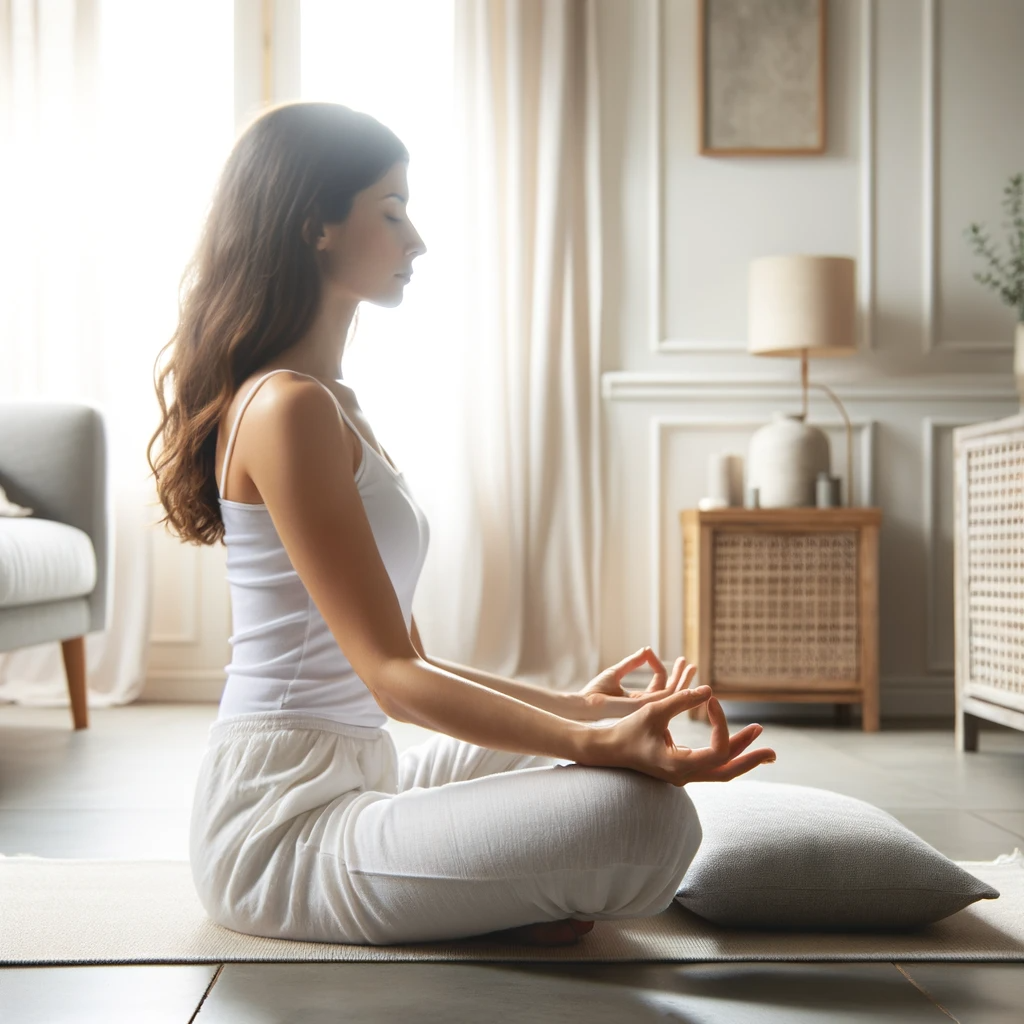“How to Meditate at Home: Simple Techniques for Inner Peace”
INTRODUCTION
Meditating is one of the most valuable life skills for reducing stress, focusing the mind, and bringing balance and inner peace amidst life’s chaos. While group classes or retreats can be highly effective at first, developing a sustainable practice ultimately requires weaving meditation into daily home routines.
This comprehensive guide covers everything you need to start meditating right from your living space, from understanding the core concepts to setting up a relaxing environment, exploring foundational techniques, building motivation through tracking benefits over time, and troubleshooting common obstacles. Follow these tips to make meditation an uplifting part of your everyday home life.
What is Meditation and How Does it Help?
Meditation is the practice of focusing the mind in the present moment to cultivate calmness, body awareness, insight, and inner balance. While complex visualizations, mantras, and mind-training do exist in some advanced practices, at its core meditation simply involves settling into mindful awareness of sensations, thoughts, and perceptions without attachment or judgment.
Regular meditation provides diverse scientifically proven benefits:
- Decreased anxiety, depression, and emotional reactivity
- Diminished fight-flight-freeze stress activation
- Lower blood pressure and cortisol
- Deeper, more restorative sleep
- Increased ability to manage pain
- Enhanced immune function
- Improved learning, memory, and cognitive flexibility
- Strengthened self-awareness and regulation
- Expanded compassion and emotional intelligence
With even 5-10 minutes of daily practice, you can transform your mind and body over time, enjoying greater resilience to life’s ups and downs.
“Incorporating a short guided meditation into my morning routine has been amazing - I handle work stress so much better. I can’t believe I waited this long to make it a habit!” - Ryan T., accountant
Now let’s explore how to cultivate your meditation practice within the comfort of home.
Creating an Inspiring Home Meditation Space
Setting aside a clean, relaxing corner or small room exclusively for your practice is ideal for getting started, even if you only have space on the floor for a single cushion. Follow this guide to designing an uplifting, distraction-free sanctuary:
Locate a Quiet Spot
Choose a part of your home distant from frequent activity, chatter, doors opening, or loud appliances to minimize sudden sounds interfering with your meditation - like a guest room, storage area, large closet, or corner.
Add Soft Furnishings
Layer plush rugs, cushions, or a yoga mat over the floor with folded blankets for extra warmth and padding during longer sits. For those who prefer chairs, choose something sturdy yet cozy.
Display Inspiring Objects
Add mementos with personal emotional resonance like stones or trinkets from nature, meaningful spiritual or religious symbols, positive affirmations, cherished photos, vision boards, artworks, plants, flowers, or small indoor fountains for a soothing ambiance.
Set the Lighting
Install dimmable lighting you can adjust to an intimate brightness, along with battery-powered candles or string lights. Softer lighting helps relaxation. Ensure a source of fresh air too.
Minimize Distractions
Store away clutter, electronics, and screens. Silence phones and disable notifications during practice times. Use white noise machines, ear plugs, or noise-canceling headphones as backup against unpredictable disruptions like garbage trucks, barking dogs, or noisy neighbors.
Building this type of soothing, protected space trains the mind and nervous system to gently turn inward rather than constantly reacting outwardly. Make it inviting to spend extended periods immersed in quietness.
Mastering Basic Meditation Techniques
While advanced meditators may focus on mantras, complex visualizations, or developing meta-awareness, a beginner-friendly home practice revolves around two simple foundations:
1. Mindfulness Meditation
This foundational technique involves cultivating non-judgmental awareness of sensations, thoughts, and perceptions as they arise, change, and fade away in each moment:
- Follow the breath flowing in and out, noticing subtle variations in depth, smoothness, and areas of expansion and contraction without controlling anything
- Feel into the different sensations in hands, feet, and legs, then expand to include sensations from the entire body simultaneously
- Allow thoughts, memories, emotions, and external sounds to come and go through the space of awareness like passing clouds, without suppressing or pursuing anything
Practice mindfulness meditation for 5-10 minutes at a time, allowing mental chatter to settle organically. This trains concentration resilience without effort.
2. Body Scans
Systematically sweeping attention through the body from head to toe and back progressively relaxes, loosens, and releases excess tension lodged on a muscular level:
- Start by relaxing jaw, face, neck, and scalp muscles using the warmth of breath and mentally soothing tight areas
- Progress down to ease shoulders, upper back, chest, arms, and hands in a similar way
- Move through the spine releasing tightness, then flow to the hips, legs, and feet
- Finally, scan back up the body 10-15 minutes daily dissolving built-up tension improves sleep quality, digestion, chronic pain, and more.
Once comfortable with mindfulness meditation and body scanning, try interspersing both practices sequentially in a single session for amplified benefits. Consistency amplifies progress over time.
Tracking Quantitative Changes with Meditation Apps
Beyond the subjective feelings of relaxation and peace after meditation, apps that sync with wearables allow precisely tracking changes in heart rate variability for stress resilience, and average resting heart rate to indicate cumulative calming of fight/flight activation and sleep efficiency day-to-day for compounding benefits.

Features like guided meditation sessions, personalized course recommendations, habit streak trackers, and journals also help adherence. Try:
- Headspace - Great for beginners seeking structure
- Insight Timer - Huge free library with diverse styles
- Calm - Soothing visuals and music
- Ten Percent Happier - Content focused on mindful movement
Seeing tangible wellness improvements reflected in numbers over the preceding days, weeks and months builds intrinsic motivation.
“I never realized how much meditation could stabilize my mood until the app showed just how extreme emotional spikes throughout my day became so rare. It's incredibly motivating to see the progress visually! 10/10 would recommend.” – Lucy D., nurse
Integrating Mini Meditations Into Daily Home Life
Once the mind gets used to resetting into present-moment awareness during formal practice, you can start casually integrating brief meditations into household activities:
- Morning Routines:
- Spend 5 minutes grounding yourself with mindful sipping of tea/coffee before rushing into work demands
- As you brush your teeth and wash your face, tune into the water sensations, smells, and textures
- Transit:
- Waiting at bus stops, gently scan and relax tension throughout the body
- At red lights during drives, take 3 slow deep breaths before proceeding
- Mealtimes:
- Before eating, appreciate the colors, arrangement, and aromas of food with all your senses
- Chew slowly, noticing taste nuances and the sensations of swallowing
- Chores:
- Folding laundry, feel soft textures and perfection in each garment with care
- Washing dishes, pay attention to soundscapes and aromas of soaps
- Nature:
- Watering plants, consciously connecting with vegetation and sunlight
- Stargazing before bed, expansively merge into the vastness of the sky
Blending mindfulness throughout everyday activities trains the brain to return to presence versus continuously drifting to autopilot or distraction. Create space before reacting.
Troubleshooting Common Home Meditation Challenges
It’s normal to encounter various obstacles as you cultivate a meditation habit. Here’s how to skillfully navigate them rather than losing consistency:
Feeling Too Restless
- Try dynamic styles like walking, qigong, or yoga meditations to harness restless momentum productively.
- Alternatively, commit to sit anyway without expectations for 5 minutes - boredom and impatience will eventually dissolve.
Constant Distractions
- Identify patterns in distractions like notifications or external noises, adjusting your environment accordingly.
- Accept and note disruptions as part of the meditation before gently re-centering attention on the body.
Trouble Quieting Mental Chatter
- Don’t force silence; allow thoughts to follow their course. Continually return focus to the breath with relaxed persistence.
- Listen to guidance like mindfulness apps if you get lost in thinking.
Lacking Motivation
- Reread this guide to reconnect with why meditation matters, and how profoundly it changes health.
- Share your challenges with a community who can relate for support and accountability.
- Consistency drives motivation. Just sit every day even if briefly, without self-judgment.
Core Takeaways on Home Meditation
- Meditation research shows incredible benefits for mental and physical health markers - make practice a priority.
- Designate a protected space for practice. Optimizing lighting, sounds, and furniture for relaxation primes the nervous system for going inward.
- Master foundational mindfulness meditation and body scanning first before exploring complex styles. Start with just 5-10 minutes daily.
- Monitor quantitative changes through meditation tracker apps and wearables for motivation. Consistency compounds subtle gains over time.
- Incorporate mini meditations during everyday home activities. Wash dishes, fold laundry, and drink coffee with conscious presence.
- Common challenges like restlessness, distractions, and self-discipline are natural. Troubleshoot obstacles skillfully without self-judgment for progress.
A few minutes of mindfulness woven into daily home life lifts everything from mood and focus to sleep quality and burnout resilience. By transforming personal living spaces into sanctuaries of stillness and inner connection, meditation becomes the backbone of health rather than an occasional add-on.
What’s your biggest question on developing a home-based meditation routine? How can you adapt the guidance in this guide to your lifestyle and needs?




